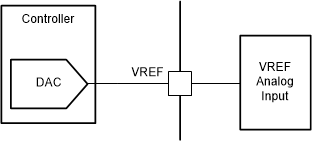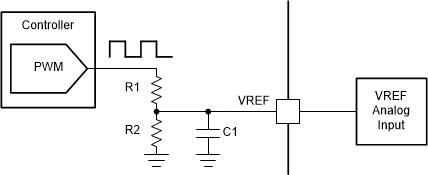SLOSEC6 August 2024 DRV8434A-Q1
PRODUCTION DATA
- 1
- 1 Features
- 2 Applications
- 3 Description
- 4 Pin Configuration and Functions
- 5 Specifications
-
6 Detailed Description
- 6.1 Overview
- 6.2 Functional Block Diagram
- 6.3
Feature Description
- 6.3.1 Stepper Motor Driver Current Ratings
- 6.3.2 PWM Motor Drivers
- 6.3.3 Microstepping Indexer
- 6.3.4 Controlling VREF with an MCU DAC
- 6.3.5 Current Regulation and Decay Mode
- 6.3.6 Charge Pump
- 6.3.7 Linear Voltage Regulators
- 6.3.8 Logic Level, Tri-Level and Quad-Level Pin Diagrams
- 6.3.9 Protection Circuits
- 6.4 Device Functional Modes
- 7 Application and Implementation
- 8 Power Supply Recommendations
- 9 Layout
- 10Device and Documentation Support
- 11Revision History
- 12Mechanical, Packaging, and Orderable Information
パッケージ・オプション
メカニカル・データ(パッケージ|ピン)
- RGE|24
サーマルパッド・メカニカル・データ
- RGE|24
発注情報
6.3.4 Controlling VREF with an MCU DAC
In some cases, the full-scale output current may need to be changed between many different values, depending on motor speed and loading. The voltage of the VREF pin can be adjusted in the system to change the full-scale current.
In this mode of operation, as the DAC voltage increases, the full-scale regulation current increases as well. For proper operation, the output of the DAC must not exceed 3.3 V.
 Figure 6-3 Controlling VREF with a DAC Resource
Figure 6-3 Controlling VREF with a DAC ResourceThe VREF pin can also be adjusted using a PWM signal and low-pass filter.
 Figure 6-4 Controlling VREF With a PWM Resource
Figure 6-4 Controlling VREF With a PWM Resource